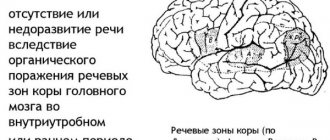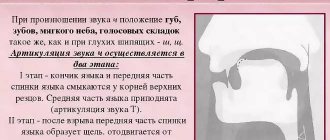The child does not pronounce hissing words: exercises for making hissing sounds, articulation gymnastics, tasks for children, video of a speech therapist.
Friends! Today I am pleased to introduce you in this article to speech therapist and defectologist Elena Shmygol. Today she will help you and your children learn how to speak hissing sounds correctly. And if you need Elena’s help, her individual Skype consultation, or you want to personally learn from her how to correctly do the exercises from the article with your child and teach your child to speak correctly with her help, then Elena’s contacts are given at the end of this article.
Correct pronunciation of the sound "sh":
When the sound is sh
pronounced correctly
- lips
are rounded and slightly extended forward; - the teeth
are close together, but not touching; - the tongue
takes the shape of a cup, its tip touching the tubercles behind the upper teeth (alveoli); the air stream is strong, warm, and comes out in the middle of the tongue.
Education w
and
z
differs only in the presence or absence of a voice, that is, the sounds
sh
and
z
are pronounced almost identically, only
sh
is voiceless, and
z
is voiced.
If a child has learned to pronounce the sound sh correctly ,
When you add a voice,
it
will work automatically.
Why do children have problems pronouncing the letter "Ш"
Many articles written by speech therapists say that before the age of five, parents should not panic if the child does not pronounce “F” or “W”, since in most cases the defects can be easily corrected at home without involving a speech therapist. The main reasons for this problem are:
- Physiological features of the structure of the baby’s speech apparatus: malocclusion, tongue size, height of the palate.
- Prolonged use of a pacifier, which subsequently affects the production of hissing sounds.
- Mangling speech by adults who constantly talk to the baby.
- Parents have speech problems.
- Hearing impairment.
- Developmental delay.
- Hyperactivity of the baby, manifested in high speed of speech without the desire to pay attention to the correct pronunciation of words.
Disturbances in the pronunciation of hissing sounds in children:
First. The absence of hissing sounds in speech or their replacement with the sound t (instead of the word “bear” the child pronounces “mika”, instead of the word “thorn” the child pronounces “type” - replaces it with t).
Possible reasons for this distortion of the sh sound are early age or impaired phonemic hearing.
Second. Replacements with f (fifka - bump).
Possible causes of sound distortion:
violation of phonemic perception., too active lip work, shortened sublingual frenulum. This replacement is called labiodental sigmatism.
Third. Replacing the sound sh with the sound s (for example, instead of “went” the child pronounces “sla”). This replacement is called whistling sigmatism.
Possible reasons for sh sound distortion:
violation of phonemic awareness. When correcting, it is necessary to teach the child to distinguish between whistling and hissing sounds!
Fourth. Lisp. This is due to the fact that, in contrast to the normal position of the organs of articulation, the tongue is pushed between the upper and lower incisors, forming a flat gap with them, the back is lowered and does not form the back of the scoop. The air stream when you bring your palm to your mouth is weak and scattered.
Possible reasons for sh sound distortion:
shortened hyoid ligament, making it difficult to lift the tongue to the palate; high and narrow hard palate. This replacement is called interdental sigmatism.
Fifth. Lateral sigmatism.
In this case, in the words he pronounces, instead of the sound sh
a peculiar squelching sound is heard. One of the corners of the lips is slightly lowered or retracted, there may be a slight shift of the lower jaw to the left or right, the lateral edges of the tongue are also lowered. When you bring your palm to your mouth, the air stream goes to the side (left or right) or comes out along both edges of the tongue, while normally the air stream should go strictly in the middle of the tongue.
Possible causes of sound distortion:
weakness of the muscles of one half of the tongue; lateral open bite.
Sixth. Nasal sigmatism.
In this case, the sound w is replaced by snoring (in the nose) or a sound similar to the deep sound x with a nasal connotation. In contrast to normal articulation, the organs of speech occupy a neutral position, the tongue is lowered down and pulled into the depths of the mouth, the back of the tongue is raised up, connecting to the soft palate, the lateral edges are lowered down. The air stream exits through the nasal cavity and not from the mouth.
Cause of sound distortion
: is excessive tension on the back of the tongue.
A complex of articulatory gymnastics for developing the correct pronunciation of hissing sounds
For articulation gymnastics you will need a mirror, cotton wool and... candy!
Each articulatory gymnastics exercise is performed 3-5 times for 5-10 seconds. The whole complex is done 3-5 times a day for 5-6 minutes .
You can watch the exercises of the complex performed in a demonstration by adults in the video of the “Spread your Wings” foundation.
Punish the naughty tongue. Open your mouth slightly, calmly place your tongue on your lower lip and, smacking it with your lips, pronounce the sounds five-five-five... Keep your wide tongue in a calm position, with your mouth open, counting from one to five to ten.
Make your tongue broad. Smile, open your mouth slightly, place the wide front edge of your tongue on your lower lip. Hold it in this position for a count of one to five to ten.
Glue on some candy. Place the wide tip of your tongue on your lower lip. Place a thin piece of toffee on the very edge of your tongue and glue a piece of candy to the roof of your mouth behind your upper teeth.
Fungus. Smile, show your teeth, open your mouth slightly and, pressing your wide tongue with its entire plane to the palate, open your mouth wide. (The tongue will resemble a thin mushroom cap, and the stretched hyoid ligament will resemble its stem.)
Who will kick the ball further? Smile, place the wide front edge of your tongue on your lower lip and, as if pronouncing the sound f for a long time, blow the cotton wool onto the opposite edge of the table.
Delicious jam. Open your mouth slightly and lick your upper lip with the wide front edge of your tongue, moving your tongue from top to bottom, but not from side to side.
Harmonic. Smile, open your mouth slightly, stick your tongue to the roof of your mouth and, without lowering your tongue, close and open your mouth (just as the bellows of an accordion stretch, so does the hyoid frenulum stretch). The lips are in a smiling position. When repeating the exercise, you should try to open your mouth wider and wider and keep your tongue in the upper position longer.
Focus. Smile, open your mouth slightly, place the wide front edge of your tongue on your upper lip so that its side edges are pressed together and there is a groove in the middle of your tongue, and blow off the cotton wool placed on the tip of your nose. The air should go in the middle of the tongue, then the fleece will fly up.
Cup. After the child learns to spread his tongue and make it wide, has mastered the tasty jam exercise, offer him: “Open your mouth slightly, make a cup out of your tongue, like I did, and place it on the tubercles behind the upper teeth. Now blow on your tongue. Do you hear how the wind rustled? Air passing through a small gap between the front edge of the tongue and the palate produces the sound sh.
How to help your child pronounce hissing sounds?
Teaching a child to pronounce the letters Zh, Ch, Sh, and Sh is a little easier than, for example, the letter R. Most often, children have a problem with the pronunciation of hissing Zh and Sh. At the same time, the sound Sh is not as annoying to the ear as the incorrectly pronounced Zh .
Usually the problem with hissing occurs because the baby is unable to relax the tongue and stretch it so that the edges touch the upper lateral teeth.
Therefore, the baby needs to be taught a few simple exercises.
- Let's relax the tongue . Place your tongue on your lower teeth, like a pancake, and tap it with your upper teeth, saying “Ta-ta-ta.” After this, the tongue should lie relaxed. Then you need to slap it with your upper lip and say “Pa-pa-pa.”
- Lifting the tip of the tongue upward . To complete the task, you need chewing candy or gum (it will be a good motivation for your child). You need him to open his mouth 2-3 cm, spread his tongue over his lower lip, sticking out its tip. Place a piece of candy on it and ask your child to stick it to the roof of his mouth behind his upper teeth. Make sure your baby only uses his tongue and not his jaw.
- Blow air through the middle of the tongue . Place a small piece of cotton wool on the table. Let the baby smile and position the tongue as in the previous task. The baby’s task is to blow the cotton wool to the other end of the table without puffing out his cheeks. At the same time, he must pronounce something like the letter F.
- Blow the cotton from your nose . The child opens his mouth slightly, places his tongue so that there is a groove in the middle of it, and the edges almost meet. We place a piece of cotton wool on the nose. The baby should take a deep breath of air through his nose and exhale sharply through his mouth. The cotton wool should fly up.
- We pronounce the sounds Zh and Sh . Ask the baby to pronounce the syllable SA, the tongue should be behind the teeth at this time. Then you need to move the tongue deeper into your mouth. As we move towards the alveoli, the sound from S turns into Sh. To get the sound Zh, we repeat the exercises, first pronouncing the syllable ZA.
- More words with Zh and Sh . Remember or come up with rhymes or tongue twisters where the letters Zh and Sh are often found in words. Repeat them with your child several times.
- We pronounce the letter H. If your baby has increased tongue tone, it will be more difficult for him to cope with the exercise at first. The sound CH consists of TH and Sh. First, the tongue should hit the alveoli, pronouncing TH, and then relax, passing the sound Sh through the slit. These two sounds, first slowly and then faster, should merge into one Ch. After several trainings, the baby will succeed !
Practice your pronunciation with different short rhymes. For example:
- There were jackdaws visiting the wolf cubs,
- There were wolf cubs visiting the jackdaw cubs,
- Now the wolf cubs are making noise like jackdaws,
- And like wolf cubs, the jackdaw cubs are silent.
Songs for sound automation
I decided to make a small addition to Elena’s article. I love music very much, and therefore I always like to sing with children in my classes. Children enjoy repeating words with the desired sound many times in songs. Therefore, I have selected simple songs with the sound Sh for you and your children.
Start with songs in which you only need to pronounce syllables with the sh sound. Next, use songs with words that contain the sound Ш. Let the child finish and sing along these words from the text. And when he already speaks the sound Ш well enough, you can use tongue twisters or complex songs (for example, the song “Horses”).
Song - a pure saying for automating the correct pronunciation of the sound Ш in syllables
Shi-shi-shi-shi, how good the candies are, Sho-sho, sho-sho, wash your hands well, Shu-shu, shu-shu, I’ll invite you to the table, Sha-sha, sha-sha we’ll eat slowly.
Song "Horses"
In the song we automate the correct pronunciation of the sound Ш in phrases.
Tips for sound production [Ш]
Learning to pronounce a sound correctly is not so easy and therefore a child needs the support of adults. Every day you need to devote about 20 minutes to the lesson.
General recommendations
Before the lesson, the child must tune in. To do this, sit him in front of a mirror and remove toys from sight. In older preschool age, lesson time should be limited to 10-15 minutes.
Due to their age, children cannot sit in one place and therefore the lesson is kept short
You don't have to do one thing the whole time. You can develop articulation and breathing apparatus, fine motor skills, and speech hearing. All this is important for speech development.
Warm up for tongue and lips
In order to teach a child to speak correctly, his muscles must be prepared. For [Ш] you need to lift the sides and tip of the tongue. The lips are made round, but do not close completely.
Important! You can print out a visual illustration of the articulatory sound profile and review it with your child.
They begin to learn the exercises gradually. Approximate complex:
- With your mouth wide open, place your tongue outstretched on your lower lip.
- Raise the edges of the tongue so that they take the shape of a “cup”.
- Round your lips and hold in this position.
Additionally, you can do an exercise to develop breathing. A small piece of cotton wool is placed on the tip of the nose and the child must blow it upward.
Exercises to determine the position of a sound
In the preparatory group, the basics of sound analysis can be taught. This is a necessary skill for mastering reading and writing. To develop this skill, you will need sound symbols - they can be taken from Agranovich's manual.
You need to start the analysis with vowel sounds - aua, uau, oao, etc. To make it easier for the child to understand about the position, they make a picture of a bird or a car. The beginning is the first sound (the bird's head), the end is the last sound (the tail), everything in between is the middle (the body).
It is better to start teaching children with vowel syllables. Only upon successful completion of this stage do they move on to combination with a vowel. Later, you can use words, but you need to be careful about the correct selection (for example, “mushroom” sounds like “flu” and should not be confused with a preschooler).
Speech development in play activities of preschoolers
Exercises to practice pronunciation
Parents do not always understand how to teach their child to say the letter Ш at home. After setting the sound, they immediately move on to automating it and for this they use direct syllables: SHA, SHO, SHU, SHI.
Then they move on to the reverse syllables: АШ, ОШ, УШ, ИШ.
Important! The child can lay out pebbles, wind threads and jump.
They move on to words and sentences only after it is possible to achieve the correct pronunciation of the sound [Ш] in syllables.
Tongue Twisters
For an introduction to independent speech, it is useful to pronounce tongue twisters during an individual speech therapy lesson on sound automation [Ш].
Tongue twisters start speaking slowly and gradually increase speed
Games with the letter Ш
After an individual lesson on making the sound [Ш], you can move on to memorizing the letter. To do this, the image is laid out from pebbles, plasticine, and counting sticks.
In preschool age, you can only write in block letters so as not to spoil your handwriting. Additionally, you can search for the letter Ш among the shaded pictures or select images that contain it.





![Producing the sound [L] to a child in stages. Articulation gymnastics, speech therapy exercises, pronunciation lessons with pictures](https://doktorobrubov.ru/wp-content/uploads/postanovka-zvuka-l-rebenku-poetapno-artikulyacionnaya-gimnastika-logopedicheskie-uprazhneniya-uroki-330x140.jpg)




